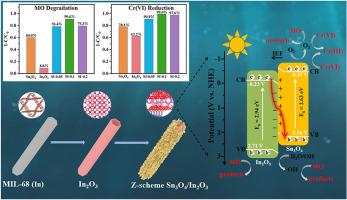Construction of a direct Z-scheme Sn3O4/In2O3 heterostructure: Boosting photocatalytic degradation of contaminants
IF 8.2
2区 材料科学
Q1 MATERIALS SCIENCE, MULTIDISCIPLINARY
引用次数: 0
Abstract
Constructing a heterostructure is regarded as one of the most promising strategies for boosting light absorption and promoting the separation of photoinduced charge carriers in the field of photocatalysis. In this study, a Z-scheme Sn3O4/In2O3 heterostructure was constructed by in-situ growth of Sn3O4 nanosheets directly on In2O3 microtubes. The optimized SI-0.1 heterostructure demonstrated superior photocatalytic activity, with degradation efficiencies of 90.6 % for methyl orange (MO) and 99.0 % for Cr(VI), respectively. Notably, the rate constants for MO photodegradation and Cr(Ⅵ) photoreduction over SI-0.1 were 2.5 and 3.5 times higher than those of pristine Sn3O4 nanosheets, and 29 and 6.3 times greater than those of In2O3 microtubes. The exceptional photocatalytic efficiency is primarily attributed to boosted visible-light absorption, elevated reactive sites, and the close contact at the dual-shell interface, which promote effective charges separation and migration. The typical Z-scheme heterojunction between Sn3O4 and In2O3 was thoroughly discussed to elucidate its photocatalytic mechanism. This work offers significant insights for designing efficient photocatalytic heterostructures for wastewater treatment applications.

直接z型Sn3O4/In2O3异质结构的构建:促进污染物的光催化降解
在光催化领域,构建异质结构被认为是促进光吸收和光诱导载流子分离最有前途的策略之一。在本研究中,Sn3O4纳米片直接在In2O3微管上原位生长,构建了z型Sn3O4/In2O3异质结构。优化后的SI-0.1异质结构具有优异的光催化活性,对甲基橙(MO)的降解效率为90.6%,对Cr(VI)的降解效率为99.0%。值得注意的是,MO光降解速率常数和Cr(Ⅵ)光还原速率常数分别是原始Sn3O4纳米片的2.5倍和3.5倍,是In2O3微管的29倍和6.3倍。优异的光催化效率主要归功于可见光吸收的增强、反应位点的升高以及双壳层界面的紧密接触,这促进了有效的电荷分离和迁移。深入讨论了Sn3O4与In2O3之间典型的z型异质结,阐明了其光催化机理。这项工作为设计用于废水处理的高效光催化异质结构提供了重要的见解。
本文章由计算机程序翻译,如有差异,请以英文原文为准。
求助全文
约1分钟内获得全文
求助全文
来源期刊

Materials Today Nano
Multiple-
CiteScore
11.30
自引率
3.90%
发文量
130
审稿时长
31 days
期刊介绍:
Materials Today Nano is a multidisciplinary journal dedicated to nanoscience and nanotechnology. The journal aims to showcase the latest advances in nanoscience and provide a platform for discussing new concepts and applications. With rigorous peer review, rapid decisions, and high visibility, Materials Today Nano offers authors the opportunity to publish comprehensive articles, short communications, and reviews on a wide range of topics in nanoscience. The editors welcome comprehensive articles, short communications and reviews on topics including but not limited to:
Nanoscale synthesis and assembly
Nanoscale characterization
Nanoscale fabrication
Nanoelectronics and molecular electronics
Nanomedicine
Nanomechanics
Nanosensors
Nanophotonics
Nanocomposites
 求助内容:
求助内容: 应助结果提醒方式:
应助结果提醒方式:


